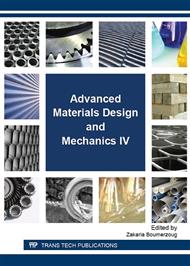[1]
S. Bruschi, T. Altan, D. Banabic, et al, Testing and modelling of material behaviour and formability in sheet metal forming, J. CIRP Annals-Manufacturing Technology. 63 (2014) 727-749.
DOI: 10.1016/j.cirp.2014.05.005
Google Scholar
[2]
J.H. Sung, J.H. Kim, R.H. Wagoner, A plastic constitutive equation incorporating strain, strain-rate, and temperature, J. International Journal of Plasticity. 26 (2010) 1746-1771.
DOI: 10.1016/j.ijplas.2010.02.005
Google Scholar
[3]
M. Sasso, A. Forcellese, M. Simoncini, et al, High strain rate behaviour of AA7075 aluminum alloy at different initial temper states, J. Key Engineering Materials. 651-653 (2015) 114-119.
DOI: 10.4028/www.scientific.net/kem.651-653.114
Google Scholar
[4]
S.Y. Lin, An investigation of die-workpiece interface friction during the upsetting process, J. Journal of Materials Processing Technology. 54 (1995) 239-248.
DOI: 10.1016/0924-0136(94)01776-x
Google Scholar
[5]
O. Pawelski, W. Rasp, C. Wolff, Analysis of the asymmetric upsetting test with extremely high strain rate as tool for friction measurement, J. Journal of Materials Processing Technology. 80-81 (1998) 287-291.
DOI: 10.1016/s0924-0136(98)00186-1
Google Scholar
[6]
S.H. Kang, K.S. Lee, Y.S. Lee, Evaluation of interfacial friction condition by boss and rib test based on backward extrusion, J. International Journal of Mechanical Sciences. 53 (2011) 59-64.
DOI: 10.1016/j.ijmecsci.2010.11.001
Google Scholar
[7]
J.C. Hung, C.C. Huang, Evaluation of friction in ultrasonic vibration-assisted press forging using double cup extrusion tests, J. International Journal of Precision Engineering and Manufacturing. 13 (2012) 2103-2108.
DOI: 10.1007/s12541-012-0278-x
Google Scholar
[8]
O.E. Kosing, B.W. Skews, An investigation of high-speed forming of circular plates in a liquid shock tube, J. International of Impact Engineering. 21 (1998) 801-816.
DOI: 10.1016/s0734-743x(98)00033-5
Google Scholar
[9]
L.F. Yang, G.L. Hu, J.W. Liu, Investigation of forming limit diagram for tube hydroforming considering effect of changing strain path, J. The International Journal of Advanced Manufacturing Technology. 79 (2015) 793-803.
DOI: 10.1007/s00170-015-6842-7
Google Scholar
[10]
Y.M. Hwang, L.S. Huang, Friction tests in tube hydroforming, J. Institution of Mechanical Engineers. 219 (2005) 587-593.
DOI: 10.1243/095440505x32517
Google Scholar
[11]
Y.M. Hwang, K.H. Wang, T.Y. Kuo, Friction tests in magnesium tube hydroforming at elevated temperatures, J. American Institute of Physics. 1353 (2011) 1765-1769.
DOI: 10.1063/1.3589771
Google Scholar


